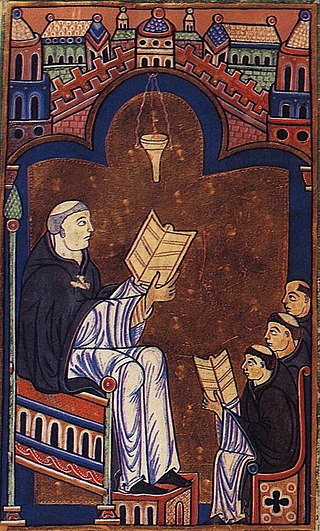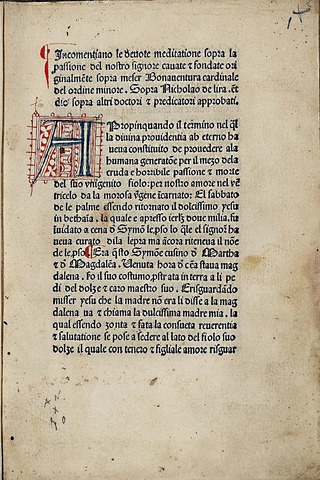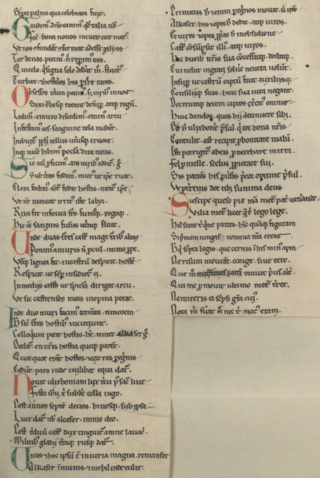Related Research Articles

Hildegard of Bingen, also known as Saint Hildegard and the Sibyl of the Rhine, was a German Benedictine abbess and polymath active as a writer, composer, philosopher, mystic, visionary, and as a medical writer and practitioner during the High Middle Ages. She is one of the best-known composers of sacred monophony, as well as the most recorded in modern history. She has been considered by scholars to be the founder of scientific natural history in Germany.

Richard of Saint Victor was a Medieval Scottish philosopher and theologian and one of the most influential religious thinkers of his time. A canon regular, he was a prominent mystical theologian, and was prior of the famous Augustinian Abbey of Saint Victor in Paris from 1162 until his death in 1173.

Jacob of Serugh, also called Mar Jacob, was one of the foremost Syriac poet-theologians, perhaps only second in stature to Ephrem the Syrian and equal to Narsai. Where his predecessor Ephrem is known as the 'Harp of the Holy Spirit', Jacob is the 'Flute of the Holy Spirit' in Antiochene Syriac Christianity. He is best known for his prodigious corpus of more than seven-hundred verse homilies, or mêmrê, of which only 225 have thus far been edited and published.
Pérotin was a composer associated with the Notre Dame school of polyphony in Paris and the broader ars antiqua musical style of high medieval music. He is credited with developing the polyphonic practices of his predecessor Léonin, with the introduction of three and four-part harmonies.

Rabanus Maurus Magnentius, also known as Hrabanus or Rhabanus, was a Frankish Benedictine monk, theologian, poet, encyclopedist and military writer who became archbishop of Mainz in East Francia. He was the author of the encyclopaedia De rerum naturis. He also wrote treatises on education and grammar and commentaries on the Bible. He was one of the most prominent teachers and writers of the Carolingian age, and was called "Praeceptor Germaniae", or "the teacher of Germany". In the most recent edition of the Roman Martyrology, his feast is given as 4 February and he is qualified as a Saint ('sanctus').

"Ave maris stella" is a medieval Marian hymn, usually sung at Vespers. It was especially popular in the Middle Ages and has been used by many composers as the basis of other compositions.

Hugh of Saint Victor was a Saxon canon regular and a leading theologian and writer on mystical theology.
Petrus Comestor, also called Pierre le Mangeur, was a twelfth-century French theological writer and university teacher.

The Abbey of Saint Victor, Paris, also known as Royal Abbey and School of Saint Victor, was an abbey near Paris, France. Its origins are connected to the decision of William of Champeaux, the Archdeacon of Paris, to retire to a small hermitage near Paris in 1108. He took on the life, vocation and observances of the Canons Regular, and his new community followed the Augustinian Rule.

Thomas of Cantimpré was a Flemish Catholic medieval writer, preacher, theologian and a friar belonging to the Dominican Order. He is best known for his encyclopedic work on nature De natura rerum, for the moral text Bonum universale de Apibus and for his hagiographical writings.

Thomas Gallus of Vercelli, sometimes in early twentieth century texts called Thomas of St Victor, Thomas of Vercelli or Thomas Vercellensis, was a French theologian, a member of the School of St Victor. He is known for his commentaries on Pseudo-Dionysius and his ideas on affective theology. His elaborate mystical schemata influenced Bonaventure and The Cloud of Unknowing.
The Glossa Ordinaria, which is Latin for "Ordinary [i.e. in a standard form] Gloss", is a collection of biblical commentaries in the form of glosses. The glosses are drawn mostly from the Church Fathers, but the text was arranged by scholars during the twelfth century. The Gloss is called "ordinary" to distinguish it from other gloss commentaries. In origin, it is not a single coherent work, but a collection of independent commentaries which were revised over time. The Glossa ordinaria was a standard reference work into the Early Modern period, although it was supplemented by the Postills attributed to Hugh of St Cher and the commentaries of Nicholas of Lyra.

Godfrey of St. Victor was a French monk and theologian, and one of the last major figures of the Victorines. He was a supporter of the study of ancient philosophy and of the Victorine mysticism of Hugh of St. Victor and Richard of St. Victor.

Achard of Saint Victor was a canon regular and abbot of the Abbey of St. Victor, Paris, and later Bishop of Avranches.
Marie of Oignies was a Beguine saint, known from the Life written by James of Vitry, for Fulk of Toulouse.
Dallas Medieval Texts and Translations is a book series founded at the University of Dallas and currently co-sponsored by the University of Dallas and Maynooth University in Ireland. The series is published by Peeters, a publishing house based in Leuven, Belgium. Modeled upon the Loeb Classical Library, the Dallas series has the goal "to build a library of medieval Latin texts, with English translations, from the period roughly between 500 and 1500, that will represent the whole breadth and variety of medieval civilization." The editorial board of the series is composed of several medievalists from the University of Dallas and Southern Methodist University; Kelly Gibson of the University of Dallas and Philipp W. Rosemann from Maynooth serve as co-editors. Members of an international board of editorial advisers review manuscripts submitted to the series to ensure their quality.

The Meditations on the Life of Christ is a fourteenth-century devotional work, later translated into Middle English by Nicholas Love as The Mirror of the Blessed Life of Jesus Christ.
This is a bibliography of Hildegard of Bingen's works.

The Historia Scholastica is a Biblical paraphrase written in Medieval Latin by Petrus Comestor. Completed around 1173, he wrote it for the cathedral school of Notre Dame in Paris. Sometimes called the "Medieval Popular Bible", it draws on the Bible and other sources, including the works of classical scholars and the Fathers of the Church, to present an overview of sacred history.

Goswin of Bossut was a Cistercian monk, crusader, composer and writer of Villers Abbey in the Duchy of Brabant.
References
- ↑ Adam of St. Peter, Sequences, Peeters Publishers
- 1 2 3 A'Becket, John Joseph (1907). . In Herbermann, Charles (ed.). Catholic Encyclopedia . Vol. 1. New York: Robert Appleton Company.
- ↑ Fassler, Margot E. (1984). "Who Was Adam of St. Victor? The Evidence of the Sequence Manuscripts". Journal of the American Musicological Society. 37 (2): 233–269. doi:10.2307/831174. ISSN 0003-0139. JSTOR 831174.
- 1 2 Julian, John. "Adam of St. Victor", Dictionary of Hymnology, 1907
 This article incorporates text from this source, which is in the public domain .
This article incorporates text from this source, which is in the public domain . - ↑ J. M. Neale, Mediaeval Hymns and Sequences, 3rd edition (1867), pp. ix–x.
- ↑ These texts were gradually rediscovered in the nineteenth century.
- ↑ The critical edition of these texts is Jean Grosfillier, ed, Les sequences d'Adam de Saint-Victor: Étude littéraire (poétique et rhétorique). Textes et traductions, commentaires, Bibliotheca Victorina 20, (Turnhout: Brepols, 2008), pp252-481. They are now fully translated in Adam of Saint-Victor, Sequences. Introduction, Text, Translation, and Notes by Juliet Mousseau, Dallas Medieval Texts, (Leuven: Peeters, 2011). In addition, Hugh Feiss, On Love, (2010), p71, argues that three additional Marian sequences seem likely to be by Adam of St Victor. The Latin text is in Bernadette Jollès, ed, Quatorze proses du XIIe siècle à louange de Marie, (Turnhout: Brepols, 1994).
- ↑ Boyd Taylor Coolman and Dale M Coulter, eds, Trinity and creation: a selection of works of Hugh, Richard and Adam of St Victor, (Turnhout: Brepols, 2010), p182.